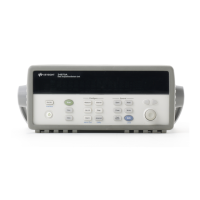The main controller, U205, is a 16-bit microcontroller incorporating
many built-in features:
• A 10-bit, successive approximation ADC with selectable inputs is
used to convert two signals: FLASH and FRQRNG. The FLASH
signal is the residual charge on the main integrating ADC output
from the internal DMM assembly (A4). The FRQRNG signal
(also from the internal DMM) is used to make voltage ranging
decisions for frequency and period measurements.
• A pulse-width-modulation port, after filtering the 23 kHz output with
R221,C224, and R259, produces DC voltages between 0V and 5V.
This voltage, PREADJ, is used to adjust the precharge amplifier
offset voltage in U101 on the internal DMM assembly (A4).
• A full, UART controlled, serial port is used to communicate with
the I/O processor through optoisolators U303 and U214. Data is
sent in an 11-bit frame at a rate of 187.5 kbits/second. The 11-bit
frame is configured for one start bit, nine data bits, and one stop bit.
• A timer is used to measure the power line frequency on LSENSE.
Frequencies between 55 Hz and 66 Hz result in the use of a 60 Hz
standard for the DMM integration period. All other frequencies
will result in the use of a 50 Hz standard.
• A 16-bit counter counts pulses on CNT to create, along with the
8-bit counter in U209, a 24-bit counter for the internal DMM.
5
Chapter 5 Theory of Operation
Floating Logic
121

